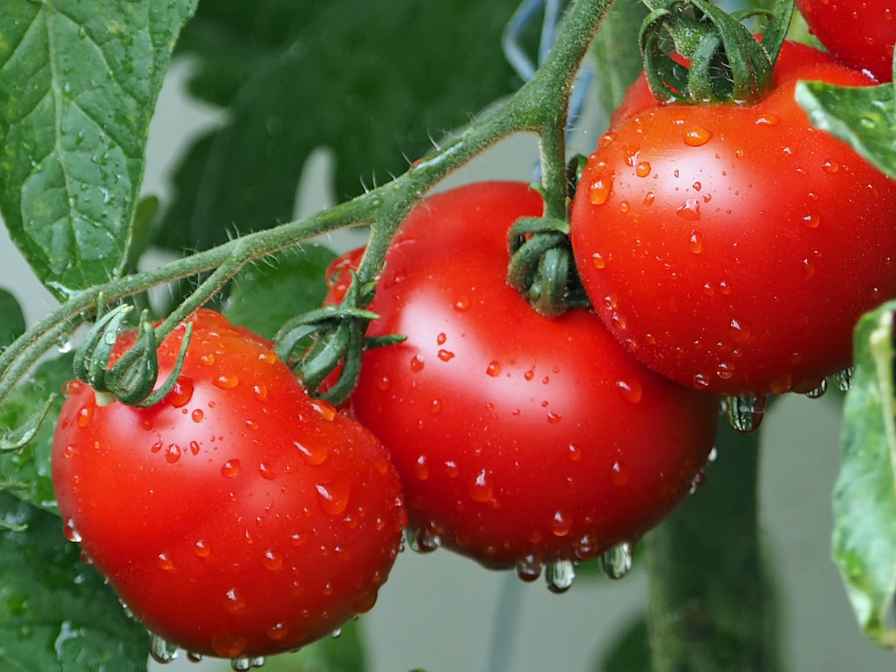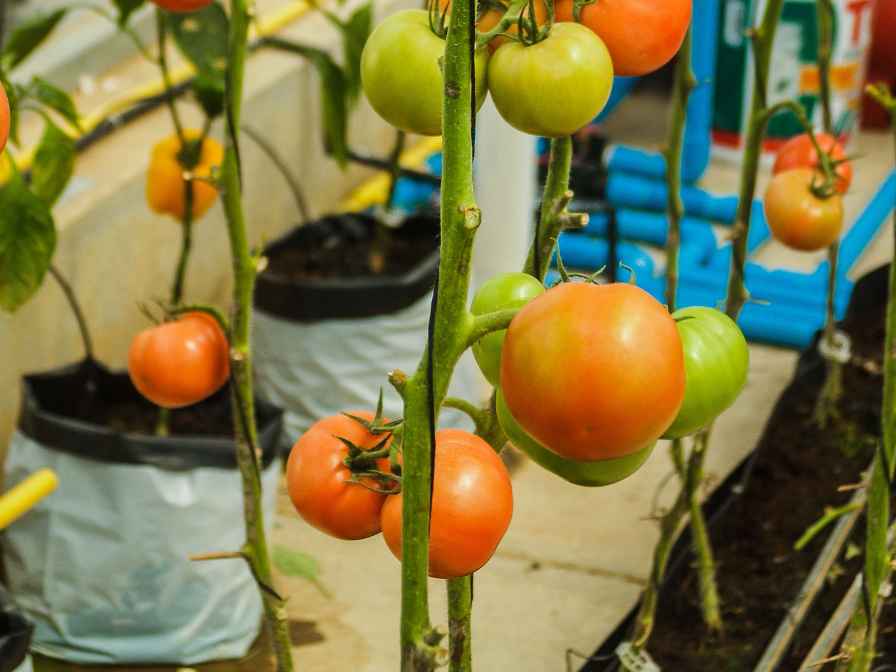When growing tomatoes, the main problem besides pests, diseases & soil conditions people come across is the watering need of tomatoes. Because scarcity of water can cause the tomato plant to die, and excess water can cause root rot and tomatoes to split. Today we are going to tell you how much water do tomato plants need.

Planting Tomatoes
Planting tomatoes is a popular and rewarding activity for gardeners and home growers alike. To start, it’s important to choose a suitable location for planting tomatoes. Tomatoes need soil that drains well, is high in organic matter, and has a pH between 6 and 7.
For optimum development and fruit production, they also require a lot of sunshine, ideally 6 to 8 hours of direct sunlight per day. Once the location is chosen, prepare the soil by removing any weeds, rocks, or debris.
Amend the soil with compost or well-rotted manure to improve its fertility and structure. Next, dig planting holes that are spaced about 2 to 3 feet apart, depending on the variety of tomatoes being planted.
Carefully remove the tomato seedlings from their pots and place them in the planting holes, making sure to bury them up to their first set of leaves. This helps the tomatoes establish a strong root system. Provide adequate care to get a good harvest. Store them or use them on spot.
Benefits of Planting Tomatoes
We are all well aware of the benefits of planting tomatoes. Here are some of these;
Fresh and Nutritious Produce
Vitamins A and C, as well as other crucial elements like potassium and lycopene, are abundant in tomatoes. By growing your own tomatoes, you may take advantage of delicious, nutrient-dense produce that is free of pesticides and dangerous chemicals.
Cost-effective
One affordable option to increase the amount of fresh food in your diet is to grow your own tomatoes. Buying tomatoes from the store can get pricey, especially if you want organic or heritage types. You may reduce your food spending and enjoy a plentiful supply of tomatoes throughout the growing season by planting tomatoes.
Gardening Enjoyment
Tomato planting may be a fruitful and pleasurable gardening task. A sense of success and joy may be gained from seeing tomato plants develop from seedlings to mature plants, from witnessing the blooms bloom to harvesting the luscious tomatoes. Also, gardening provides a means of de-stressing, exercising, and a chance to commune with nature.
Customization and Control
You have control over the variety, growing environment, and cultivation techniques when you cultivate your own tomatoes. You may experiment with various growing methods, such as container gardening or vertical trellising, and select from a variety of tomato types that might not be sold in supermarkets.
By doing this, you may personalize your tomato-growing process and get the desired outcomes.
Sustainable and Eco-friendly
Growing tomatoes in your own garden encourage environmental responsibility and sustainability. By using organic or natural gardening techniques, you may stay away from the usage of dangerous pesticides or chemicals.
Also, producing your own tomatoes lowers the amount of packaging and shipping required for store-bought fruit, lowering your carbon footprint and promoting a more sustainable way of living.
Community Engagement
By giving the harvest to friends, family, or nearby food banks, tomato planting may help promote community involvement. You may share your crop with others, generating a sense of community and generosity. Tomatoes are a versatile element in many cuisines.
How Much Water do Tomato Plants Need?

The water needs of tomato plants can vary depending on various factors such as the stage of growth, weather conditions, soil type, and container size (if grown in containers). Here are some general guidelines for watering tomato plants
Watering Frequency for Tomato Plant
To keep the soil continuously wet but not saturated, tomato plants often require regular watering. Throughout their growing season, tomato plants often require 1 to 1.5 inches of water every week.
However, this may vary depending on factors such as temperature, humidity, and rainfall. It’s important to monitor the moisture level of the soil and adjust the watering accordingly. Avoid letting the soil dry out completely between watering, as this can cause stress to the plants and affect fruit development.
Watering Method
Water tomato plants at the base, near the root zone, and avoid overhead watering, as wet leaves can increase the risk of disease. Drip irrigation, soaker hoses, or watering cans are good options for delivering water directly to the root zone, promoting efficient water uptake by the plants.
Time of Day to Water Tomato
Water tomato plants in the morning or early afternoon, when the weather is cooler, to minimize evaporation and allow the plants to take up water before the hotter part of the day. Avoid watering in the evening, as prolonged moisture on the leaves during cool nights can promote fungal diseases.
Soil Moisture
Tomato plants prefer well-drained soil that is evenly moist, but not waterlogged. Overwatering can lead to root rot and other fungal diseases while underwatering can cause wilting, poor fruit development, and blossom-end rot. Check the moisture level of the soil by sticking your finger about an inch into the soil, and water when it feels slightly dry at that depth.
Weather Conditions
Hot and dry weather can increase the water needs of tomato plants, while cooler or more humid conditions may require less frequent watering. During prolonged periods of high heat or drought, tomato plants may need additional water to maintain optimal moisture levels in the soil.
Mulching
Mulching the soil around tomato plants with organic materials like straw, wood chips, or leaves can help retain soil moisture, reduce evaporation, and regulate soil temperature. Mulching also helps to suppress weeds, which can compete with tomato plants for water and nutrients.
Plant Maturity
As tomato plants mature and develop deeper root systems, they may be able to tolerate slightly drier soil between watering. However, it’s still important to monitor soil moisture and provide adequate water to prevent stress and ensure healthy growth and fruit production.
You must know that these are general guidelines and the actual water needs of tomato plants may vary depending on the specific growing conditions and tomato variety. Regularly monitor the moisture level of the soil, observe the condition of the plants, and adjust watering accordingly to ensure optimal growth and productivity of your tomato plants.
In a nutshell, tomatoes need water varying in variety. Also, it is the time of the season and the condition of the plant. You need to follow the procedure keeping in mind the variety, conditions, and the time of the season. Like at start and growth, it needs more water, and at fruiting and ripening it needs just the bare minimum.
FAQs
Can you overwater tomatoes?
Just provide enough water as needed. It is because when there is less water, plants can simply die. If you overwater it, it can cause root rot, or if there is ripening season tomatoes can split. Just provide enough water when the upper layer of the soil is dry.
What are the signs of tomato overwatering?
You will see that the stems and leaves will get yellow and wilted. Also, overwatering can cause root rot as well. When there is ripening and fruiting, tomatoes can split due to overwatering.
How do you increase tomato yield?
Besides providing all of the care, you need to go for consistent watering. Inconsistent watering can cause a loss in tomato yield. A good watering schedule can increase tomato yield along with fulfilling other requirements

